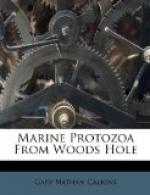Length 135 mu; greatest width 40 mu.
[Illustration: Fig. 51.—Amphisia kessleri.]
This variety differs from O. kessleri as described by Wrzesniowski in having three frontal cirri instead of four. Another difference is in the structure of the nuclei and in their position. These differences are too minute to warrant a specific name. O. velox of Quennerstedt is probably the same as 0. kessleri, but differs in having three complete rows of ventral cirri. O. velox has three frontal cirri in a line, thus differing from the Woods Hole form.
KEY TO THE MARINE GENERA OF EUPLOTIDAE.
Diagnostic characters: Cilia, as well as the frontal, marginal, and ventral cirri, very much reduced; the anal cirri, on the other hand, are always present. The macronucleus is band-form.
1. Frontal cirri more than 8 2
Frontal cirri less than 8 3
2. Eleven marginal cirri on the left Genus
Certesia
side; 11 frontal cirri
Four marginal cirri, 2 on each
Genus *_Euplotes_
side; 9 to 10 frontal cirri
3. Seven frontal, 5 anal, 3 right Genus
*_Diophrys_
marginal, and 2 left marginal
cirri
No frontal, 5 anal, 3 right,
Genus *_Uronychia_
and 2 left marginal cirri
* Presence at Woods Hole indicated by asterisk.
Genus EUPLOTES (Ehr. 1831) Stein ’59.
(Ehrenberg ’31, ’38; Stein ’59; Cl. & Lach. ’58; Quennerstedt ’65, ’67, ’69; Buetschli ’88; Kent ’81; Gourret & Roeser ’88; Moebius ’88.)
Small to medium-sized forms. Rigid in form, colorless, or green by chlorophyl. They are quite flat on the ventral surface but decidedly arched dorsally, and the contour is usually oval. The anterior end is broadly rounded to truncate; the posterior end is similarly rounded, or may be somewhat pointed. The mouth is placed centrally or near the left margin, and from it the right edge of the peristome forms a curved line to the left, which bends forward, thus making the greater part of the left edge the peristomial area. In front the peristome bends sharply to the right and extends as far as the right end of the adoral zone. Upon the frontal and median ventral surface are 9 to 10 great cirri (Bauchwimpern of Stein). Posteriorly five great anal cirri stretch out beyond the posterior body margin. In addition to these there are two smaller marginal cirri upon the left body edge, and two similar ones on the hinder part of the body. The dorsal surface is rarely smooth, but usually is marked by longitudinal ridges, and rows of dorsal bristles have been described. The single contractile vacuole lies on the right side in the region of the anal cirri, sometimes just above them, sometimes below. The anus is posterior and on the right side. The characteristic macronucleus is long and band-form, its main portion being usually on the left side with an anterior and a posterior arm toward the right. Movement is rapid swimming, which, however, is frequently broken by creeping periods, during which the animals appear to be examining the foreign body on which they creep.




